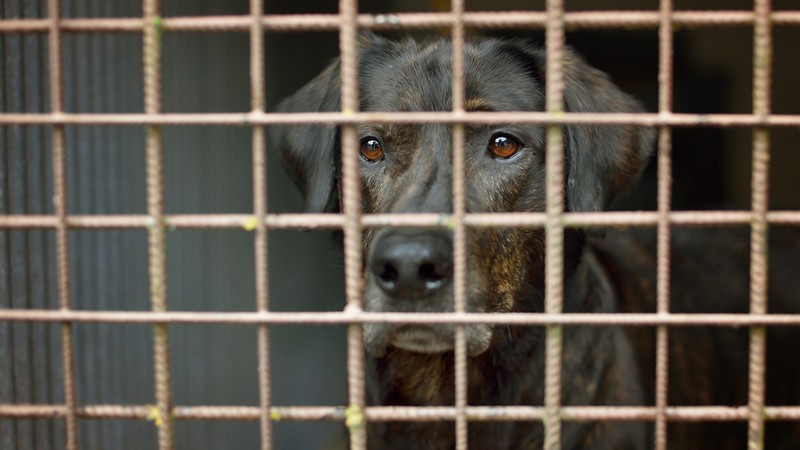Adjustment Issues with an Adopted Dog
This two-year-old dog is a mix of messes

Separation anxiety, barking, the zoomies, scaring the cat – this newly adopted dog is experiencing all the classic adjustment issues. See what animal advisor Cathy M. Rosenthal suggests the writer about her “grand-dog” in this installment of My Pet World.
Dear Cathy,
My son adopted a two-year-old Shepherd/Doberman mix from a shelter. The dog loves people, and that seems to be the problem. He can’t be left alone. If they put him in his crate, he barks constantly. He was not neutered until they adopted him. The vet said he has separation anxiety and that once his testosterone levels go down, it should help.
He told them to use calming chews and pheromone sprays, but they worked only for a while. He is in training classes. Sometimes, he listens; and sometimes, he doesn’t. They keep him on a leash in the house and backyard. My son sleeps in a recliner because the dog will not sleep in his crate at night. They were told to feed the dog in the crate, which they do, but he doesn’t want to stay in it. He also sometimes does what my son calls the “zoomies.”
They love him, and so do I. But they have had to change their lifestyle, and so has their cat, who is petrified of the dog. Please give us some ideas to make him feel secure enough to be left alone.
– Suzy, Coram, New York
Dear Suzy,
A newly adopted dog usually needs help adjusting to his new home. I assume the dog’s kennel is in the family room because that’s where your son sleeps. That’s excellent; it should always be where the family hangs out the most. Most dogs whine if they can’t sleep near their families at night, so he should consider adding a second kennel upstairs.
I wonder though, why the dog needs to sleep in the kennel at night and again during certain times of the day. It sounds like too much kennel time, which might explain the “zoomies.” The zoomies mean he needs more physical and mental stimulation, which your son can provide through daily training, play sessions, and leashed walks.
Let’s start with training. Tell your son to work on the “sit,” “down,” “stay,” “come,” and “kennel” commands. He should use a clicker or reward word, like bingo, to mark the desired behavior, followed by a treat. Giving the dog his meals, treats, chews, and puzzle toys in the kennel is a great way to begin kennel training – and keep his mind busy. (If he’s busy, he has less time to worry.)
Have your son say “kennel” as he places the food in the kennel. Use the clicker or reward word when the dog enters the kennel, followed by a high-value treat. Once the dog appears occupied with the food or activity, your son can leave the room for 30 seconds and then return. If the dog barks or whines, he can shorten the time away. If he doesn’t bark or whine, he can use the clicker or reward word to mark the quiet behavior followed by a treat. Over time, your son can build up the number of times he leaves the room and the time he is gone. This helps the dog learn your son can leave but will always return.
When the dog is content with your son being gone for 30 minutes, he should be fine to leave in the kennel for an hour or two. (If gone any longer, please have him hire a pet sitter to break up the dog’s day with play sessions.) Once the dog associates the kennel with fun things, he will become more comfortable in it.
Please note: Except for eating or playing with a toy, the kennel should remain open as much as possible. Never use the kennel as punishment or as a cage where he spends most of his time.
Related: Sweet dog rescued from hoarding still scared
As for the cat, introductions should always be done slowly (over days) with the dog on a leash. If the dog chased or scared the cat during the first introduction, this dynamic has now been set up. Before re-introducing them, have your son train the dog with the “leave it” command. This can be taught whenever the dog goes after something, like food or the cat, that your son wants him to leave alone.
To make the cat feel safe again, make sure there are places where the cat can jump or hide to get out of the dog’s reach.
I’m unsure if this is actual separation anxiety or just anxiety and pent-up energy colliding in an unfamiliar environment. However, if your son trains him every day, teaches him that his leaving doesn’t mean forever, plays with him, and walks him, the dog should learn to be calmer and less anxious.
Cathy M. Rosenthal is a longtime animal advocate, author, columnist, and pet expert who has more than 25 years in the animal welfare field. She addresses reader questions as diverse as outdoor cat safety to adjustment issues with adopted dog. Send your pet questions, stories, and tips to cathy@petpundit.com. Please include your name, city, and state. You can follow her @cathymrosenthal.
© Tribune Content Agency, LLC
Boomer has vetted all products recommended in Pet World articles, so you don’t have to! As an Amazon Associate, Boomer Magazine earns from qualifying purchases of linked products.


